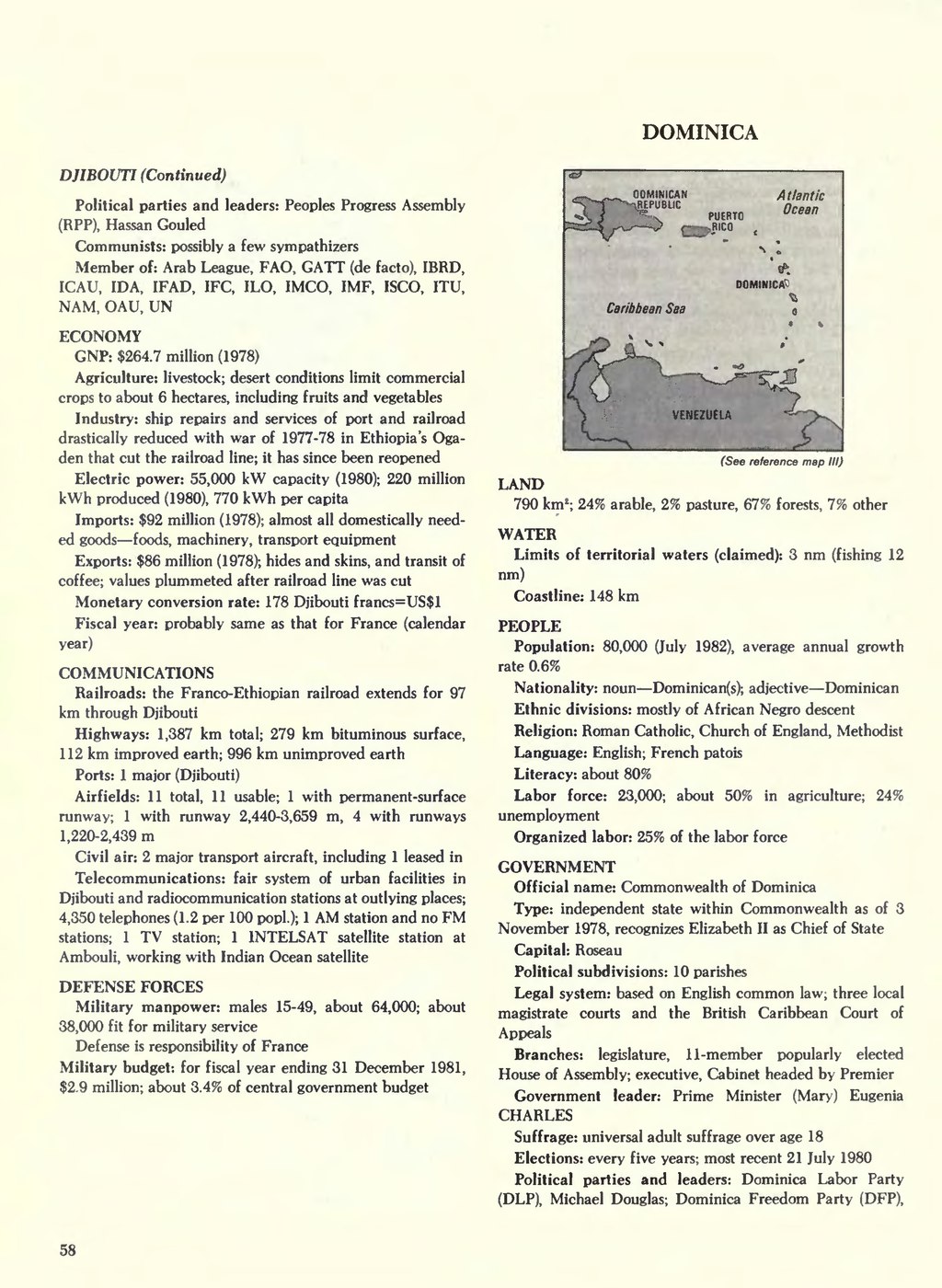DJIBOUTI (Continued)
Political parties and leaders: Peoples Progress Assembly (RPP), Hassan Gouled
Communists: possibly a few sympathizers
Member of: Arab League, FAO, GATT (de facto), IBRD, ICAU, IDA, IFAD, IFC, ILO, IMCO, IMF, ISCO, ITU, NAM, OAU, UN
ECONOMY
GNP: $264.7 million (1978)
Agriculture: livestock; desert conditions limit commercial crops to about 6 hectares, including fruits and vegetables
Industry: ship repairs and services of port and railroad drastically reduced with war of 1977-78 in Ethiopia's Ogaden that cut the railroad line; it has since been reopened
Electric power: 55,000 kW capacity (1980); 220 million kWh produced (1980), 770 kWh per capita
Imports: $92 million (1978); almost all domestically needed goods—foods, machinery, transport equipment
Exports: $86 million (1978); hides and skins, and transit of coffee; values plummeted after railroad line was cut
Monetary conversion rate: 178 Djibouti francs=US$1
Fiscal year: probably same as that for France (calendar year)
COMMUNICATIONS
Railroads: the Franco-Ethiopian railroad extends for 97 km through Djibouti
Highways: 1,387 km total; 279 km bituminous surface, 112 km improved earth; 996 km unimproved earth
Ports: 1 major (Djibouti)
Airfields: 11 total, 11 usable; 1 with permanent-surface runway; 1 with runway 2,440-3,659 m, 4 with runways 1,220-2,439 m
Civil air: 2 major transport aircraft, including 1 leased in
Telecommunications: fair system of urban facilities in Djibouti and radiocommunication stations at outlying places; 4,350 telephones (1.2 per 100 popl.); 1 AM station and no FM stations; 1 TV station; 1 INTELSAT satellite station at Ambouli, working with Indian Ocean satellite
DEFENSE FORCES
Military manpower: males 15-49, about 64,000; about 38,000 fit for military service
Defense is responsibility of France
Military budget: for fiscal year ending 31 December 1981, $2.9 million; about 3.4% of central government budget
DOMINICA

|
| (See reference map II) |
LAND
790 km2 ; 24% arable, 2% pasture, 67% forests, 7% other
WATER
Limits of territorial waters (claimed): 3 nm (fishing 12 nm)
Coastline: 148 km
PEOPLE
Population: 80,000 (July 1982), average annual growth rate 0.6%
Nationality: noun—Dominican(s); adjective—Dominican
Ethnic divisions: mostly of African Negro descent
Religion: Roman Catholic, Church of England, Methodist
Language: English; French patois
Literacy: about 80%
Labor force: 23,000; about 50% in agriculture; 24% unemployment
Organized labor: 25% of the labor force
GOVERNMENT
Official name: Commonwealth of Dominica
Type: independent state within Commonwealth as of 3 November 1978, recognizes Elizabeth II as Chief of State
Capital: Roseau
Political subdivisions: 10 parishes
Legal system: based on English common law; three local magistrate courts and the British Caribbean Court of Appeals
Branches: legislature, 11-member popularly elected House of Assembly; executive, Cabinet headed by Premier
Government leader: Prime Minister (Mary) Eugenia CHARLES
Suffrage: universal adult suffrage over age 18
Elections: every five years; most recent 21 July 1980
Political parties and leaders: Dominica Labor Party (DLP), Michael Douglas; Dominica Freedom Party (DFP),
